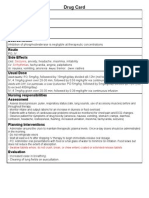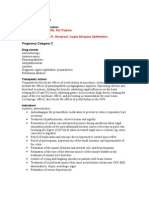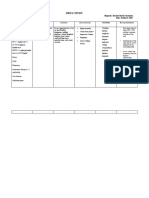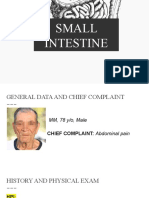Drug Cards
Drug Cards
Uploaded by
Michael LongsCopyright:
Available Formats
Drug Cards
Drug Cards
Uploaded by
Michael LongsCopyright
Available Formats
Share this document
Did you find this document useful?
Is this content inappropriate?
Copyright:
Available Formats
Drug Cards
Drug Cards
Uploaded by
Michael LongsCopyright:
Available Formats
Oxycodone/Acetaminophen (Percocet, Endocet, Magnacet, Primalev, Roxicet, Roxilox, Tylox)
Classification: Opioid agonists, opioid agonists/nonopioid analgesic combinations
Schedule II drug/ Controlled substance must be locked up and counted before dispensing
Indication: Management of moderate to severe pain (give patients pain info)
Contraindications: (Do not give) If hypersensitivity to oxycodone/acetaminophen, Severe Hepatic/Renal disease,
OB, Lactation Use Cautiously: Head trauma, increased intracranial pressure, severe renal, hepatic pulmonary disease
Dosage Range: Oxycodone: PO Adults more than or equal to 50kg) 5-10 mg q 3-4 hr prn | PO Adults less than 50kg
or Children 6-12yr 1.25mg q6hr prn or 0.2mg/kg q3-4hr prn| PO children >12: 2.5mg q6hr prn | Rectally(Adults):
10-40mg 3-4 times daily prn
Available as: (Know which dose you are giving according to MD order)
Percocet 2.5/325 Percocet 5/325 Percocet 7.5/325 Percocet 7.5/500 Percocet 10/325 Percocet 10/650
Major Side Effects: Oxycodone: CNS: confusion, sedation, dizziness, dysphoria, euphoria, floating feeling,
hallucinations, headache, unusual dreams EENT: blurred vision, diplopia, miosis Respiratory Depression CV:
orthostatic hypotension GI: constipation, dry mouth, nausea, vomiting GU: urinary retention Skin: flushing,
sweating Misc: Physical/psychological dependence, tolerance
APAP Side Effects: Hepatic failure, Hepatotoxicity, renal failure (high doses) (4 G/ Day)
Nursing Implications: (Information Specific to your Patient) Always check for allergies
Assessment: assess type, location, and intensity of pain prior to and 1hr after administration.
ASESS: BP/ Pulse/ and Respirations before and periodically during admin.
Hold If respiratory rate is <10/min assess level of sedation ; Physical stimulation may be sufficient to prevent
significant hypoventilation. Assess bowel function routinely. Prevention of constipation should be instituted with
increased intake of fluids and bulk, and laxatives to minimize constipating effects. Stimulant laxatives should be
administered routinely if opioid use exceeds 2-3 days, unless contraindicated
LAB test: may increase plasma amylase and lipase levels.
Oxycodone/Aspirin (Percodan, Endodan)
Classification: Opioid agonists/ nonopioid analgesic combination
Schedule II drug/ Controlled substance ( must be locked up and counted before dispensing)
Indication: Management of moderate to severe pain (give pt pain info)
Contraindications: (Do not give) If hypersensitivity to oxycodone/aspirin, tartrazine, or other salicylates. Bleeding
disorders or thrombocytopenia. Children or adolescents w/ viral infections (reye’s syndrome) Severe Hepatic/Renal
disease, OB, Lactation Use Cautiously: Head trauma, increased intracranial pressure, severe renal, hepatic
pulmonary disease
Dosage Range: Oxycodone: PO Adults more than or equal to 50kg) 5-10 mg q 3-4 hr prn / PO Adults less than
50kg or Children 6-12yr 1.25mg q6hr prn or 0.2mg/kg q3-4hr prn / PO children >12: 2.5mg q6hr prn
Rectally(Adults): 10-40mg 3-4 times daily prn / Aspirin: do not exceed 4g/day
Available As: (know which dose you are giving according to MD order) 4.88mg oxycodone + 325mg
Major Side Effects: Oxycodone: CNS: confusion, sedation, dizziness, dysphoria, euphoria, floating feeling,
hallucinations, headache, unusual dreams EENT: blurred vision, diplopia, miosis Respiratory Depression CV:
orthostatic hypotension GI: constipation, dry mouth, nausea, vomiting GU: urinary retention Skin: flushing,
sweating Misc: Physical/psychological dependence, tolerance
Aspirin: GI: GI bleeding dyspepsia, epigastric distresss, nausea, abdominal pain, anorexia hepatotoxicity, vomiting
Exfoliative dermatitis, stevens-johnson syndrome, toxic epidermal necrolysis, anemia, hemolysis, increased
bleeding time
Nursing Implications: (Information Specific to your Patient) Always check for allergies.
Assessment: assess type, location, and intensity of pain prior to and 1hr after administration.
ASESS: BP/ Pulse/ and Respirations before and periodically during admin.
Hold If respiratory rate is <10/min assess level of sedation ; Physical stimulation may be sufficient to prevent
significant hypoventilation. Assess bowel function routinely. Prevention of constipation should be instituted with
increased intake of fluids and bulk, and laxatives to minimize constipating effects. Stimulant laxatives should be
administered routinely if opioid use exceeds 2-3 days, unless contraindicated
LAB test: may increase plasma amylase and lipase levels.
Omeprezole (Prilosec, Prilosec OTC) Classification: proton-pump inhibitors
Indication: GERD/maintenance of healing in erosive esophagitis. Duodenal ulcers (w/ or w/o anti-infectives for
Helicobacter pylori) Short term treatment of active benign gastric ulcer. Pathologic hypersecretory
conditions(Zollinger-Ellison syndrome) Reduction of risk of GI bleeding in critically ill pts. OTC: Heartburn
occurring more or equal to twice/week.
Dosage Range: PO(Adults): GERD/erosive esophagitis 20mg once daily. Duodenal ulcers ass. w/ H. Pylori 40mg
once daily in the morning w/ clarithromycin for 2wk then 20mg daily for 2wk or 20 mg twice daily w/
clarithromycin 500mg twice daily and amoxicillin 1000mg twice daily for 10 days(if ulcer present at beginning of
therapy, continue omeprazole 20 mg daily for 18 more days) gastric ulcer 40mg 1x/day for 4-6 wk.
PO (Children 1-16yr and 5-9kg) GERD 5mg daily PO (Children 1-16yr and 10-19kg): GERD 10mg 1x/day
PO (Children 1-16yr and equal to or more than 20kg) 20mg/day
Major Side Effects: CNS: dizziness, drowsiness, fatigue, headache, weakness CV: chest pain GI: abdominal pain,
acid regurgitation, constipation, diarrhea, flatulence, nausea, vomiting Skin: itching, rash Misc: allergic reactions.
Nursing Implications: Assess pt. routinely for epigastric or abdominal pain and frank or accult blood in the stool,
emesis, or gastric aspirate LAB Test: Monitor CBC w/ differential periodically during therapy, may increase AST,
ALT, alkaline phosphatase and bilrubin, may cause serum gastrin concentrations to increase first 1-2wk of therapy.
Monitor INR and prothrombin time in pt’s taking warfarin.
Give before meals preferable in the morning. Do not crush/chew capsule. Capsules may be sprinkled on cool
applesauce (ingest immediately & drink water) (do not store for future use)
Mylanta II, DS- Magnesium Hydroxide/aluminum hydroxide (Alamag, Gaviscon, Simethicone, Maalox, Mylanta
DS)
Classification: Antiacids
Indication: useful in a variety of GI complaints, including Hyperacidity, Indigestion, GERD, Heartburn,
excess gas (simethicone) (helps belching/ passing flatus)
Contraindications: (Do not give) severe abdominal pain of unknown cause, especially if accompanied by
fever; renal failure, (CrCl <30 ml/min)
Dosage Range: Magnesium/Aluminum Hydroxide: PO Adults & Children >12 yr 5-10ml or 1-2 tabs 1-3 hr
after meals and at bedtime.
Major Side Effects: GI: Constipation, diarrhea, hypermagnesemia, hypophosphatemia
Nursing Implications: Assess for heartburn and indigestion as well as location, duration, character, and
precipitating factors of gastric pain
LAB Test Considerations: Monitor Serum phosphate, potassium, and calcium levels periodically during
chronic use. May cause increased serum calcium and decreased serum phosphate concentrations
You might also like
- Diagnostic Therapeutic Algorithms in Internal Medicine For Dogs and CatsDocument529 pagesDiagnostic Therapeutic Algorithms in Internal Medicine For Dogs and Catsluisfilipesilvamoreira19No ratings yet
- CholestyramineDocument1 pageCholestyramineKatie McPeekNo ratings yet
- Lanoxin (Digoxin)Document3 pagesLanoxin (Digoxin)E100% (5)
- Drug CardDocument1 pageDrug CardDuangkamol UasapwasinNo ratings yet
- Lopressor (Metoprolol) IVDocument2 pagesLopressor (Metoprolol) IVAdrianne Bazo100% (1)
- Drug DigoxinDocument1 pageDrug DigoxinSrkocherNo ratings yet
- Drug Card Tricyclic DepressantsDocument2 pagesDrug Card Tricyclic DepressantsAaLona RobinsonNo ratings yet
- Piracetam 800mg TabletsDocument5 pagesPiracetam 800mg TabletsSuvaneel MoulickNo ratings yet
- Drug Cards BarryDocument6 pagesDrug Cards BarryJessica Lynn DyeNo ratings yet
- Colace Drug CardDocument1 pageColace Drug CardBenNo ratings yet
- Aerovent, Apovent Atronase, Ipraxa, Ipvent Rhinovent, Rinatecrinovagos, Atrovent, Atrovent HfaDocument4 pagesAerovent, Apovent Atronase, Ipraxa, Ipvent Rhinovent, Rinatecrinovagos, Atrovent, Atrovent HfaGwyn RosalesNo ratings yet
- Metoclopramide (Reglan)Document1 pageMetoclopramide (Reglan)ENo ratings yet
- Drug PrilosecDocument1 pageDrug PrilosecSrkocher100% (1)
- Generic Name.Document2 pagesGeneric Name.Methyle Ann IsulatNo ratings yet
- Generic Name: Brand Name: Pharmacologic Class: Action: CNS: DizzinessDocument8 pagesGeneric Name: Brand Name: Pharmacologic Class: Action: CNS: DizzinessMaricon BautistaNo ratings yet
- Plavix (Clopidogrel)Document1 pagePlavix (Clopidogrel)E50% (2)
- Drug StudyDocument6 pagesDrug StudyLouise Adrene SevillaNo ratings yet
- LortabDocument1 pageLortabSheri490No ratings yet
- Dolan Drug StudyDocument3 pagesDolan Drug StudyLian Robbie BautistaNo ratings yet
- Generic Name: BudesonideDocument8 pagesGeneric Name: BudesonidemeangelmeNo ratings yet
- Rathna Drug Card LisinoprilDocument1 pageRathna Drug Card Lisinoprilerdos13No ratings yet
- PrevacidDocument1 pagePrevacidAdrianne BazoNo ratings yet
- Drug DilantinDocument1 pageDrug DilantinSrkocherNo ratings yet
- Medication: Expected Pharmacological Action Therapeutic UseDocument1 pageMedication: Expected Pharmacological Action Therapeutic UseAli GarciaNo ratings yet
- BrivaracetamDocument110 pagesBrivaracetamBendisDacicaNo ratings yet
- AcetaminophenDocument3 pagesAcetaminophenShaira Tan100% (1)
- Risperdone and Lithium CarbonateDocument4 pagesRisperdone and Lithium CarbonateFionah RetuyaNo ratings yet
- Drug StudyDocument9 pagesDrug StudyChristine PunsalanNo ratings yet
- Serratiopeptidase Is An Enzyme Having AntiDocument12 pagesSerratiopeptidase Is An Enzyme Having Antidracula386No ratings yet
- Drug StudyDocument5 pagesDrug StudyJann Zaniel Allayne RiNo ratings yet
- CaspofunginDocument2 pagesCaspofunginSapna thakurNo ratings yet
- NUR 201 - Drug Study (Lanthanum Carbonate)Document1 pageNUR 201 - Drug Study (Lanthanum Carbonate)ReaNo ratings yet
- Temazepam (Restoril)Document1 pageTemazepam (Restoril)Adrianne BazoNo ratings yet
- AmloDocument1 pageAmloamy navajaNo ratings yet
- Vancomycin Protocol RQHRDocument15 pagesVancomycin Protocol RQHRl1o2stNo ratings yet
- DrugsDocument20 pagesDrugsLee Won100% (1)
- Hyoscine ButylbromideDocument2 pagesHyoscine ButylbromideKenneth ColeNo ratings yet
- Drug StudyDocument6 pagesDrug Studyjohnclement_dcNo ratings yet
- EnalaprilDocument2 pagesEnalaprilAyah PaasaNo ratings yet
- HemodialysisDocument2 pagesHemodialysisjustin_saneNo ratings yet
- Valproic AcidDocument4 pagesValproic AcidAndrea Huecas TriaNo ratings yet
- Anticholinergics Study Drug ListDocument1 pageAnticholinergics Study Drug ListDrima Edi100% (1)
- Drug Study 2019Document14 pagesDrug Study 2019Aubrey Unique Evangelista50% (2)
- Atropine SulfateDocument5 pagesAtropine Sulfateapi-3797941100% (1)
- Drug Card Week 2Document4 pagesDrug Card Week 2stacylynnschmidt8No ratings yet
- Drug Study: Patient: B.V Age: 58y/oDocument2 pagesDrug Study: Patient: B.V Age: 58y/oAndrea Sibayan SorianoNo ratings yet
- DRUGSDocument5 pagesDRUGSDanica EspejoNo ratings yet
- CymbaltaDocument2 pagesCymbaltaENo ratings yet
- Albendazol PDFDocument8 pagesAlbendazol PDFDANIBATANo ratings yet
- Drug MetronidazoleDocument1 pageDrug MetronidazoleSrkocherNo ratings yet
- Torvastatin Drug StudyDocument2 pagesTorvastatin Drug StudyRoland YusteNo ratings yet
- DR Weatherby Chem Screen Tracking FormsDocument5 pagesDR Weatherby Chem Screen Tracking FormsDANIELANo ratings yet
- Bisacodyl DulcolaxDocument1 pageBisacodyl DulcolaxENo ratings yet
- Furosemide (Lasix)Document1 pageFurosemide (Lasix)E100% (3)
- Drug StudyDocument11 pagesDrug StudyNedemar OcampoNo ratings yet
- Drug GlucotrolDocument1 pageDrug GlucotrolSrkocherNo ratings yet
- The Ride of Your Life: What I Learned about God, Love, and Adventure by Teaching My Son to Ride a BikeFrom EverandThe Ride of Your Life: What I Learned about God, Love, and Adventure by Teaching My Son to Ride a BikeRating: 4.5 out of 5 stars4.5/5 (2)
- COMPREHENSIVE NURSING ACHIEVEMENT TEST (RN): Passbooks Study GuideFrom EverandCOMPREHENSIVE NURSING ACHIEVEMENT TEST (RN): Passbooks Study GuideNo ratings yet
- NURSING CARE OF ADULTS II: Passbooks Study GuideFrom EverandNURSING CARE OF ADULTS II: Passbooks Study GuideNo ratings yet
- DrugmedsDocument52 pagesDrugmedsshirleyNo ratings yet
- Medications: Medication Name Generic/Trade Classification Pregnancy CategoryDocument8 pagesMedications: Medication Name Generic/Trade Classification Pregnancy CategoryapalestiNo ratings yet
- MURMURDocument21 pagesMURMURtoyyibNo ratings yet
- Medicine Exam NotesDocument211 pagesMedicine Exam Notesjf65ky8f8tNo ratings yet
- EMT HESI Prep Flashcards PT 1Document4 pagesEMT HESI Prep Flashcards PT 1Emily Caller100% (1)
- Uraemic Cardiomyopathy: A Review of Current LiteratureDocument9 pagesUraemic Cardiomyopathy: A Review of Current Literaturemmbire@gmail.comNo ratings yet
- Brain Map For MRCEM OSCE - PaperbackDocument100 pagesBrain Map For MRCEM OSCE - PaperbackBelal HasanNo ratings yet
- NBME 17 Block 1Document50 pagesNBME 17 Block 1Fiorella Vicenty93% (100)
- 11BCDocument23 pages11BCMuhammad Qamar NazirNo ratings yet
- Cephalosporins Cephalosporins: Jagir R. Patel Asst Professor Dept. PharmacologyDocument30 pagesCephalosporins Cephalosporins: Jagir R. Patel Asst Professor Dept. PharmacologyJagirNo ratings yet
- Additional Notes - LilyDocument8 pagesAdditional Notes - LilyMarti N BaccayNo ratings yet
- Small Bowel ObstructionDocument38 pagesSmall Bowel ObstructionRUSSELL CILOTNo ratings yet
- 1 of 1 - My Health SummaryDocument210 pages1 of 1 - My Health SummaryCandace DeihlNo ratings yet
- Word Bank: Process of Breathing in and Breathing Out. of The Body. ArteriesDocument2 pagesWord Bank: Process of Breathing in and Breathing Out. of The Body. ArteriesjakeNo ratings yet
- Pharma Evaluation 3Document13 pagesPharma Evaluation 3janina mykaNo ratings yet
- Amlodipine - Drug Information - UpToDateDocument9 pagesAmlodipine - Drug Information - UpToDateBárbaraNo ratings yet
- Krok2 - Medicine - 2006 PDFDocument26 pagesKrok2 - Medicine - 2006 PDFBadriya YussufNo ratings yet
- Activity 2 Midterm Worksheet Proteins Nutrition and Diet Therapy LabDocument11 pagesActivity 2 Midterm Worksheet Proteins Nutrition and Diet Therapy LabckkyleNo ratings yet
- Nutrition Therapy For Liver Diseases Based On TheDocument8 pagesNutrition Therapy For Liver Diseases Based On Thepainah sumodiharjoNo ratings yet
- Drug Study - 5 DrugsDocument5 pagesDrug Study - 5 DrugsApril FlorendoNo ratings yet
- Therapeutic Diet For Specific ConditionsDocument9 pagesTherapeutic Diet For Specific ConditionssendogzNo ratings yet
- IDA and AsthmaDocument5 pagesIDA and AsthmacatherineNo ratings yet
- Tuberculosis TB Pathophysiology Schematic DiagramDocument3 pagesTuberculosis TB Pathophysiology Schematic Diagramkatrin anne f. carpenaNo ratings yet
- Soil Transmitted HelminthiasisDocument9 pagesSoil Transmitted HelminthiasisSuperboinkyNo ratings yet
- Iii. Clinical Reasoning Questions-CollaborationDocument16 pagesIii. Clinical Reasoning Questions-CollaborationAjie ZamNo ratings yet
- Topicslist Sure Shot 150 Dr. NikitaDocument6 pagesTopicslist Sure Shot 150 Dr. NikitaShashiNo ratings yet
- Home Nursing and First AidDocument28 pagesHome Nursing and First AidMatigari SeniorNo ratings yet
- Week 9 TheoryDocument17 pagesWeek 9 TheoryabextekNo ratings yet
- Cerebrovascular Accident ThesisDocument8 pagesCerebrovascular Accident Thesisgjgwmp01100% (2)
- BBB NBME FINAL Exam Session Objectives 2022Document29 pagesBBB NBME FINAL Exam Session Objectives 2022Chandrally MahajanNo ratings yet
- Lab Report 1 Gastrointestinal DiseaseDocument4 pagesLab Report 1 Gastrointestinal DiseaseVioletta MaharaniNo ratings yet

























































































